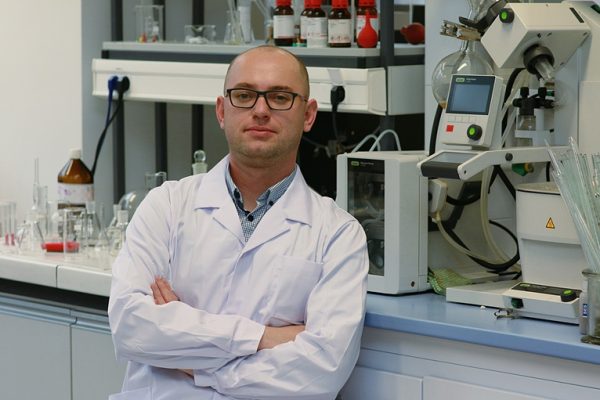World Cancer Day is celebrated on 4 February. We often hear how important it is to undergo preventive examinations that allow to detect a developing disease at its early stage. We also know that the number of cancer cases increases each year.
Scientists around the world conduct intensive research intended to develop new, more effective and safer anti-cancer therapies. Researchers associated with the University of Silesia in Katowice also participate in this difficult fight against cancer. One of them is chemist, Dr. Eng. Maciej Serda, who tells us about the hopes connected with nanomedicine.
‘I worked in American research centres for three years and took part in innovative research in the field of medical chemistry and nanomedicine. I mainly focused on synthesising fullerene derivatives – carbon nanostructures that were to be used as drug carriers. I decided to come back to Silesia, where together with the team of great scientists in the group of Prof. Robert Musioł we have continued the research on these and other low molecular chemicals, which have a huge potential for new anti-cancer therapies.’
Pancreatic cancer, which is the particular focus of scientists from the University of Silesia, is not an easy rival. It is one of aggressive and difficult-to-cure cancers. It frequently develops without any signs, and when the first symptoms appear, it is usually too late for effective drug therapy or surgical removal of the affected organ. The main drug used in chemotherapy is gemcitabine, which prolongs the life of patients with advanced form of the disease only by several months. It is a deeply unsatisfactory result.
‘This type of cancer usually forms firm frames for its tissues, which is why the medical substances used simply cannot get there. Nanomedicine can be helpful here’, says Dr. Eng. Maciej Serda.
Nanomedicine is nothing else but the nanotechnology research used in medicine. Nanoparticles range from 1 to 100 nm, constituting one milionth part of a milimeter. For comparison, an average bacterium is one thousand times bigger (its size usually ranges from 1 µm to 10 µm), and a grain of sand may even be one hundred thousand times bigger.
The particle size is of key significance. A cancerous tumour usually develops very fast. Its tissue demonstrates specific metabolic and physiological properties. One of its elements is the chaotically growing vessels. This process results in holes, whose diameter may range between 100 and 1,000 nM.
‘In a way, such tumour cancer tissue has “holes”. Its increased vascular permeability is the so-called EPR (enhanced permeability and retention) effect, which is interesting from the point of view of nanomedicine, because properly designed nanomaterials with medical substances can easily penetrate through the tumour tissue walls to malignant cells and destroy them’, explains the scientist from the University of Silesia.
Although everything seems to be simple in theory, the practice reveals a long and expensive way to offer new effective drugs and cancer treatment.
‘The scientific discipline represented by our team is medical chemistry. For us, chemical compounds characterised by two features – high biological activity and selectivity are at the very top of research prestige. In other words, they have to operate the way we want them to in a precisely determined area of a living organism’, says Dr. Eng. Maciej Serda.
As a result, it would be possible to offer a medical substance that operates exclusively in cancer cells and is administered in small (nanomolar), safe doses.
‘This is what we are looking for’, adds the scientist.
To design such a compound, the chemists use algorithms and large databases that contain billions of possible combinations of elements. Based on this, we can initially select the compounds that are interesting in terms of the target molecular objective and obtain information regarding the optimum route for their synthesis. The following step consists in organic synthesis of chemical compounds with the highest potential, carried out in the university laboratories. Then begins the biological test phase – in vitro, tested on cancer cells and in vivo – tested on living organisms.
‘Thanks to the efforts of Assoc. Prof. Anna Mrozek-Wilczkiewicz, among others, we have at our disposal a very-well equipped laboratory for performing analyses in the field of molecular biology. For example, we can test the toxicity of synthesized compounds, which has key significance when developing substances for medical purposes. I also closely cooperate with Prof. Jarosław Polański, Prof. Robert Musioł and Dr. Katarzyna Malarz’, stresses the scientist.
‘We also have our own cancer cell bank that we can use for carrying out the in vitro tests and watch the efficiency of compounds synthesized by us at the cell level’, he adds. A part of the cell lines are imported to our team from the USA, directly from the National Cancer Institute (NCI). Additionally, Dr. Eng. Maciej Serda took two postdoctoral internships in USA, at the University of Chicago (in the group of Prof. Viresh Rawal) and at the Rice University (in the group of Prof. Lon J. Wilson). The scientists also continue close cooperation with the Jagiellonian University, where tests on animal models are carried out.
‘Currently, my most advanced research concerns water-soluble fullerene derivatives. These are allotropic varieties of carbon, which are not only an interesting carrier of medical substances, but they can also interact with biological targets. Irradiated with a beam of appropriate wavelength, they release reactive oxygen forms, which kill cancer cells without damaging the healthy cells at the same time. Moreover, they have a high degree of water solubility, which has key significance in the context of drugs.’
‘I found a research niche for myself. These are further interesting compounds that I have been watching for a couple of years now. Thanks to combining forces in interdisciplinary approach to designing functional nanomaterials, we have a bigger chance to offer and patent an effective chemical compound in therapy of diseases such as pancreatic cancer, skin cancer or breast cancer’, says the chemist.
‘In this way, we get actively involved in the global race to combat cancers’, he sums up.
Dr. Eng. Maciej Serda is the head of the project entitled “New glycofullerenes in cancer therapies” financed in SONATA competition by the National Science Centre.
Małgorzata Kłoskowicz | Press Section
Contact
- Dr. Eng. Maciej Serda, Faculty of Sicence and Technology at the University of Silesia in Katowice, e-mail: maciej.serda@us.edu.pl.







